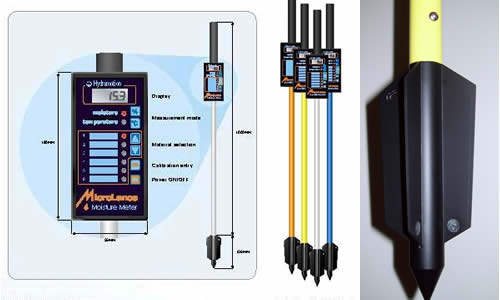Just how to Use a Moisture Meter to Identify Concealed Water Damages in Your Residential property
Just how to Use a Moisture Meter to Identify Concealed Water Damages in Your Residential property
Blog Article
The Ultimate Guide to Wetness Meters: A Comprehensive Summary and Exactly How They Can Save You Cash
Dampness meters serve as essential devices in discovering and monitoring moisture content in products, helping in stopping expensive problems and guaranteeing the quality of products. Understanding the subtleties of different types of wetness meters, their applications, and the potential cost-saving benefits they provide can be a game-changer for organizations and professionals alike.
Kinds of Moisture Meters
Different sorts of dampness meters are readily available for various applications in numerous sectors. One usual type is the pin-type wetness meter, which gauges the electrical resistance in between two pins put right into a product. This type appropriates for wood, drywall, and other structure materials. Pinless moisture meters, on the other hand, use electromagnetic sensor plates to check a larger area without causing damages to the product's surface. Moisture Meter. These meters are optimal for swiftly examining wetness degrees in huge locations such as walls and floorings.

Infrared dampness meters determine the thermal residential or commercial properties of a product to identify its moisture content non-invasively, making them useful for applications where pin or pinless meters may not be ideal. Recognizing the various types of dampness meters offered can help sectors choose the most proper device for their specific dampness measurement needs.

Benefits of Utilizing Dampness Meters
Wetness meters offer indispensable advantages in precisely monitoring and assessing wetness degrees in diverse products and settings (Moisture Meter). Among the primary benefits of making use of moisture meters is the prevention of potential damages caused by excess dampness. By spotting and attending to high dampness degrees early on, moisture meters assist to stop mold development, rot, and architectural damages in buildings, saving both money and time on repair work. Additionally, moisture meters help in ensuring the quality of materials during building or production procedures. By properly gauging moisture web content, these devices help maintain the honesty of wood, drywall, concrete, and other materials, minimizing the threat of flaws or failures.
Additionally, making use of moisture meters can lead to increased power performance. In farming setups, dampness meters play a crucial duty in optimizing plant yields by allowing farmers to keep track of dirt wetness levels and make notified watering decisions.
How to Choose the Right Moisture Meter
Selecting the proper dampness meter includes considering key elements such as product compatibility, dimension variety, and calibration precision. When choosing a wetness meter, it's necessary to ensure that the meter appropriates for the certain product you will be screening. Different products have differing electrical residential or commercial properties that can impact moisture analyses, so selecting a meter developed for your material is essential for exact results. Additionally, consider the dimension variety of the dampness meter. Guarantee that the meter can find wetness degrees within the array needed for your applications. Calibration accuracy is an additional vital element to bear in mind. Choose a moisture meter with dependable calibration to ensure exact and regular analyses. Some meters may need regular calibration modifications, so understanding the calibration process is crucial. By carefully reviewing these factors, you can choose a dampness meter that fulfills your demands and provides accurate wetness dimensions for your projects.
Appropriate Methods for Dampness Meter Usage

Cost Financial Savings Via Dampness Meter Applications
Exactly how can the strategic usage of dampness meters lead to significant cost financial savings across different markets? In the agriculture industry, moisture meters aid in determining the optimal time for harvesting crops, protecting against excess or over-drying moisture that can affect the last product's top quality.
Similarly, in construction, wetness meters help avoid costly damages by detecting wetness levels in structure materials, such as timber or concrete, which can result in structural issues if not addressed immediately. By recognizing issue locations early on, contractors can take rehabilitative actions to avoid substantial repairs or replacements, inevitably saving time and money.
Furthermore, in the food processing market, moisture meters are crucial for checking product top quality and making sure conformity with safety and security guidelines. By properly measuring moisture material in food products, makers can prevent putridity, keep quality, and decrease waste, causing substantial price financial savings. Generally, the strategic application of dampness meters is a beneficial financial investment that can result in substantial cost reductions and improved performance throughout different markets.
Verdict
To conclude, moisture meters are beneficial devices for measuring and finding moisture levels in numerous products. By making use of the appropriate moisture meter and following proper methods, customers can effectively stop pricey damages triggered by excess dampness. Buying a top quality dampness meter can result in considerable price savings in the future by recognizing potential problems at an early stage and making it possible for prompt remediation. Ultimately, wetness meters are vital tools for preserving the honesty and longevity of structures and materials.
Dampness meters offer as crucial tools in detecting and keeping an eye on moisture content in materials, assisting in stopping expensive damages and making sure the top quality of items. Infrared dampness meters gauge the a fantastic read thermal homes of a material to establish its wetness web content non-invasively, making them useful for applications where pin or pinless meters may not be suitable.Wetness meters use important advantages in properly keeping an eye on and evaluating moisture degrees in diverse materials and atmospheres. In agricultural setups, wetness meters play a vital duty in maximizing plant yields by making it possible for farmers to keep track of dirt wetness degrees and make notified watering choices.In verdict, wetness meters are useful tools for discovering and measuring moisture degrees in numerous products.
Report this page